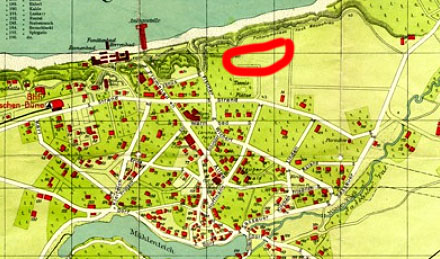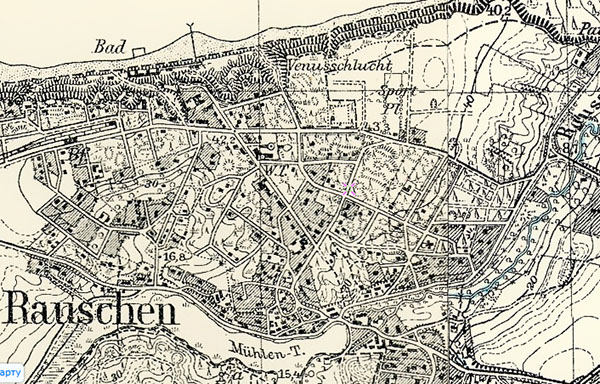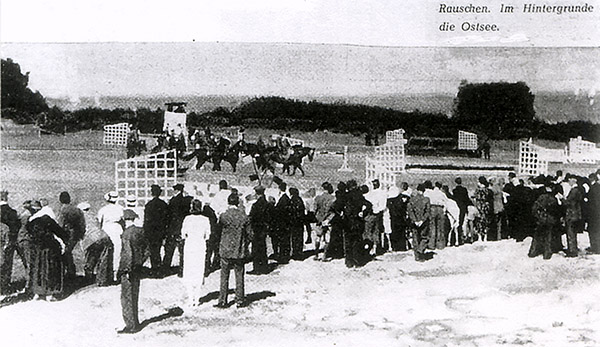Hippodrome and equestrian tournaments in Rauschen

Even before 1920, on the eastern edge of Rauschen, on the undeveloped dunes between the coastal cliff and the main street Strand (now Lenin Street), tennis courts, a sports field and a children's playground appeared. In a brochure published in 1920 for the 100th anniversary of the resort, the city authorities noted that the "Samland Society of Riders and Horse Breeders" (Samländische Reiter- und Züchterverein) intended to create a racecourse here.
The 1926 city plan of Rauschen already showed this field, called Renn- und Turnierplatz (translated as "place for horse racing and tournaments"). Today, the site of the former hippodrome (for simplicity, we will use this term) is a city park to the east of the "Amber Hall".
The hippodrome had no clear boundaries. Most likely, its dimensions were 300 by 200 m. The hippodrome surface was ordinary sand. It is impossible to say for sure whether there were any permanent structures for equestrian sports and spectators at the hippodrome.

It can be assumed that the hippodrome had several different venues for competitions in a fairly large range of sports disciplines.
Paul Gusovius in his book "Kreis Samland" notes that in 1928 "...competitions were held on a picturesque site near the Baltic Sea coast near the resort of Rauschen. Rauschen had a reputation as the best place in the province for equestrian competitions, riders willingly came here and brought their horses. The competitions here invariably took place in a friendly, benevolent atmosphere. Local riders also participated...". Thus, it can be assumed that the competitions that took place on July 14-15, 1928 were not held for the first time.

In September of the same year, in the equestrian magazine St. Georg, in the article “The Second Competition in Bad Rauschen”, it was noted:
“As a direct consequence of the extremely successful provincial tournament in Rauschen, the Samland Riders and Horse Breeders’ Society together with the Schaaken Riders’ Club held a second tournament on the following Saturday and Sunday, 21st and 22nd July.
The weather also favoured this enterprise; but the attendance was not nearly so strong as eight days before.
The event was perfectly organized and was dominated by the sporty, forward-looking spirit of the Samland breeders. It is this spirit that has led to the tournament ground in Rauschen, which was created only a few years ago and until recently was not very well known, <…> now taking its place immediately after Insterburg…"
Let us now turn to the list of disciplines at the tournaments in Rauschen. Among them were both actual sports competitions and, apparently, some kind of horse appearance competitions, where the jury assessed the exterior of the animal. Most likely, this was the competition for hunting horses ( Eignungsprüfung für Jagdpferde) for the "Blütgericht" prize.
Among the sports competitions were:
hunting horse races ( Jagdrennen) for the Rauschen Prize;
equestrian eventing ( Vielseitigkeitsprüfung) for the Nodems Prize (Preis von Nodems);
East Prussian Horse Breeders' Prize race;
steeplechase ( Querfeldeinrennen) for the prize of the city of Königsberg;
Dressage ( Dressurprüfung) for the Curonian Lagoon Prize;
steeplechase racing for hunter horses (Ausgleichsjagdspringen).
In 1929, the magazine "St. George" in the article "Tournament and races in Rauschen" described this event as follows:
"The competition was organised by the Samland Society of Riders and Horse Breeders together with the Schaaken Riders' Club on 21 and 28 July 1929.
This year, Rauschen was once again a magnet for riders and spectators. After all, over the two days of the tournament, about 400 applications were received, and by 10 a.m. on Sunday, all the places were already sold out. Bright sunshine and an exemplary program ensured a complete success for the two organizing clubs.
The tournament ground itself has shown some noticeable improvements compared to last year. It would be very helpful if Rauschen could, with funding from the state and private foundations, include a third hunter race in its daily program. In this regard, I would like to raise the question that it would be more expedient in the interests of the clubs to arrange the tournament days in East Prussia in such a way that the clubs do not hold their tournaments on the same day.
On July 21, the competitions in Rauschen and Budweten (I was unable to identify the current name of this settlement. — admin ) coincided, and on July 28, in Rauschen and Łyk (now Elk, Poland. — admin ), which could have been avoided if a little goodwill had been shown."
This year's disciplines included, among others, eventing (24 riders participated), steeplechase and steeplechase with betting (14 riders participated; there was a massive pile-up during the competition).
A competition for racehorses ( Eignungsprüfung für Reitpferde) with a prize was held especially for female riders. Another competition was organized for harness horses.
The Samland Railway Prize Hunter Horse Race was held over a distance of 3,600 m.
The Rauschen Grand Prix, contested by 10 riders, was a hunter race over a distance of 3000 m.
The pony races were a particular delight for the audience, with thunderous applause at the end.
The popularity of the equestrian competitions in Rauschen grew year after year. In 1931, the number of spectators on the first day alone exceeded 3,000 people. The Rauschen tournament, being not as large as the competitions in Insterburg, gave the opportunity to participate not only to experienced athletes, but also to young people from small rural equestrian clubs. In the same 1931, between the two tournament days, team competitions were held between members of riding clubs from the regions of Königsberg and Fischhausen. Athletes from the region of Fischhausen won.
It is not known how long the competitions were held in Rauschen. It is also not known what happened to the hippodrome after the end of World War II. Perhaps the first settlers who ended up in Rauschen could clarify the picture. But it seems that if there were no capital buildings at the hippodrome, then there might not have been any special traces of the former equestrian battles on the Baltic coast.
